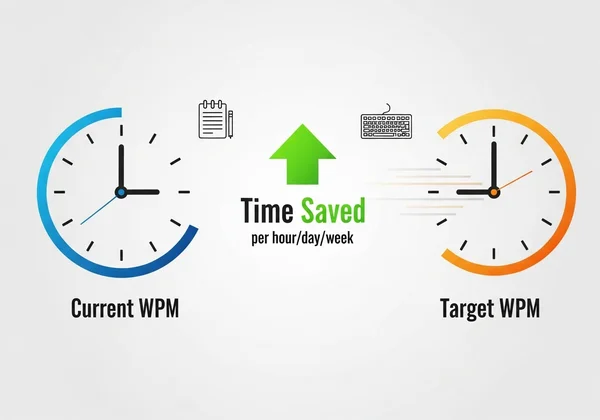WPM Test ROI: Calculate Your Typing Speed Productivity Gain Online
Are you constantly battling the clock, wishing for more hours in your day? What if a simple skill improvement could gift you back significant time each week? This guide isn't just about faster typing; it's about translating your typing test results into tangible productivity gains and understanding the Return on Investment (ROI) of enhancing this foundational skill. For professionals, every minute saved is a minute that can be reinvested into deep work, strategic thinking, or simply a better work-life balance. How can I test my typing speed and accuracy? The journey to unlocking this hidden efficiency starts with a simple benchmark, one you can discover in seconds with a free WPM test online.

Understanding Your WPM Test Productivity: Beyond Just Speed
Before we can calculate the return on investment of improving your typing, it’s crucial to understand how your typing speed test score directly impacts your daily WPM productivity. It’s not just a metric for typists; it's a key performance indicator for anyone who uses a keyboard.
What is WPM and Why Does It Matter for Professionals?
Words Per Minute (WPM) is a standard measure of typing speed, calculating how many words you can correctly type in sixty seconds. For writers, developers, marketers, and administrators, this metric is a direct reflection of output efficiency. A higher WPM means drafting emails, writing code, creating reports, and communicating with colleagues happens faster. In a world where communication is constant, transferring your thoughts to the screen without friction is a professional superpower. It reduces the gap between idea and execution, allowing you to maintain momentum and stay in your creative or analytical flow.
The Hidden Costs of Slow Typing: Time, Errors, and Frustration
The consequences of slow typing extend far beyond a few wasted seconds. The costs accumulate daily, creating significant drains on your time and energy. A typist at 30 WPM takes twice as long to produce the same document as someone at 60 WPM. Over a week, this can amount to hours of lost productivity. Furthermore, slow typing is often linked to high error rates. The constant cycle of backspacing, correcting, and re-reading disrupts your concentration and invites frustration, turning simple tasks into draining chores. This hidden friction in your workflow is a silent killer of efficiency and job satisfaction.

The WPM ROI Formula: How to Calculate Your Time Savings
This is where theory meets practice. You can calculate the tangible time savings from improving your typing speed with a straightforward formula. This isn't just a motivational exercise; it's a data-driven way to justify investing time in practice.
The basic formula is: Daily Time Saved = (Daily Typing Time in Minutes) x (1 - (Current WPM / Target WPM))

Let's break down how to apply this to your own work.
Step-by-Step: Measuring Your Current Typing Efficiency
You can't improve what you don't measure. The first and most critical step is to establish your baseline WPM score. A reliable and accurate test is essential for this.
- Find a Quiet Moment: Ensure you have 1-3 minutes without distractions for an accurate reading.
- Take the Test: Use a clean, ad-free platform to measure your speed. It’s crucial to focus on both speed and accuracy. To get an immediate and precise benchmark, measure your speed right now.
- Record Your Score: Note your WPM and accuracy percentage. For our calculation, we'll use the WPM score. Repeat the test a few times to get a consistent average.
Real-World Examples: WPM Improvement Case Studies
Let's see the ROI formula in action with a few professional scenarios:
-
Case Study 1: The Content Writer
- Daily Typing Time: 4 hours (240 minutes)
- Current WPM: 45
- Target WPM: 75
- Calculation: 240 x (1 - (45 / 75)) = 240 x (1 - 0.6) = 240 x 0.4 = 96 minutes.
- ROI: By increasing her speed, the writer saves 96 minutes (over 1.5 hours) every single day. That's over 8 hours a week—an entire workday—reclaimed for editing, research, or creative brainstorming.
-
Case Study 2: The Software Developer
- Daily Typing Time: 2.5 hours (150 minutes) of pure coding and documentation.
- Current WPM: 55
- Target WPM: 80
- Calculation: 150 x (1 - (55 / 80)) = 150 x (1 - 0.6875) = 150 x 0.3125 = 46.8 minutes.
- ROI: The developer gains nearly 47 minutes daily, which can be used for debugging, testing, or learning a new framework.
Customizing Your ROI: Factors Affecting Your Personal Gains
Your personal ROI will vary based on several factors. The volume of text you produce daily is the biggest multiplier. A journalist will see a more dramatic time-saving gain than an executive who primarily delegates. Furthermore, the type of text matters. Typing complex code with special characters is different from typing prose. Consider your specific role and daily tasks to create a realistic estimate of your potential productivity gains.
Maximizing Your Typing Efficiency: Actionable Strategies
Knowing your potential ROI is the motivation; a smart strategy is the path to achieving it. Improving your typing efficiency requires more than just random practice. It involves setting clear goals and using the right tools for continuous improvement.
Setting Achievable WPM Goals for Tangible Results
Instead of aiming to double your speed overnight, set small, incremental goals. A realistic target is to increase your WPM by 5-10 words every two weeks. This approach keeps you motivated and allows your muscle memory to develop sustainably. Track your progress weekly to see the results of your effort, which reinforces the habit of practicing.
Leveraging Our Free Typing Test Platform for Continuous Improvement
A dedicated practice tool is your best ally. The features on our platform are designed not just to test, but to train. Here’s how to leverage it:
- Benchmark Regularly: Use the standard typing speed test to monitor your progress against your goals.
- Practice with Purpose: Use the custom text feature to practice with materials relevant to your job, such as code snippets, legal jargon, or common email responses. This builds practical, job-specific speed.
- Focus on Feedback: Pay attention to the real-time highlighting of correct and incorrect characters. This immediate feedback loop helps you identify and correct habitual errors on the fly.
Beyond Speed: Accuracy, Ergonomics, and Consistent Practice
True typing efficiency is a trifecta of speed, accuracy, and endurance.
-
Accuracy First: A 99% accuracy at 60 WPM is far more productive than 90% at 80 WPM, as editing takes more time than typing correctly in the first place.
-
Proper Ergonomics: Ensure your desk, chair, and keyboard are positioned correctly to prevent strain and fatigue. Good posture enables longer, more comfortable typing sessions.
-
Consistency is Key: Just 10-15 minutes of focused practice each day is more effective than one long session per week. Make it a part of your daily routine.

Invest in Your Fingers: Unlock Your Productivity Potential
Improving your typing speed through a consistent typing test regimen is one of the highest-leverage investments you can make in your professional development. It’s a skill that pays dividends every single day, in every task you perform. The time you save isn't just a number; it's regained focus, reduced stress, and unlocked potential.
The journey starts with a single benchmark. Ready to calculate your own WPM ROI and start reclaiming your time? Take our typing speed test today and discover a more efficient, productive you.
Frequently Asked Questions About Typing Speed & Productivity
How is a WPM test calculated and why is accuracy important?
WPM is typically calculated by taking the number of characters typed (including spaces), dividing by five to represent an average word, and then dividing by the test duration in minutes. Accuracy is critical because every error requires time to correct, which significantly lowers your net productivity. High accuracy is the foundation of effective typing speed.
What is a good score on a typing test for professionals?
While the average typing speed is around 40 WPM, professionals in typing-intensive roles should aim for 60-80 WPM. A score of 70 WPM or higher is considered highly proficient and provides a significant productivity advantage, allowing you to keep pace with your thoughts and workflow demands.
How can I improve my typing speed test results for work?
The most effective way is through consistent, deliberate practice. Focus on mastering touch typing to avoid looking at the keyboard, prioritize accuracy over initial speed, and use online tools for daily drills. Regular practice on a platform like our free WPM test tool is essential for measurable improvement.
Is 70 WPM a good typing speed for productivity?
Yes, 70 WPM is an excellent typing speed for productivity. It allows you to complete text-based tasks much faster than the average person, reducing friction in your workflow and freeing up substantial amounts of time. At this speed, your fingers can easily keep up with the flow of your ideas, leading to higher-quality output and less mental strain.